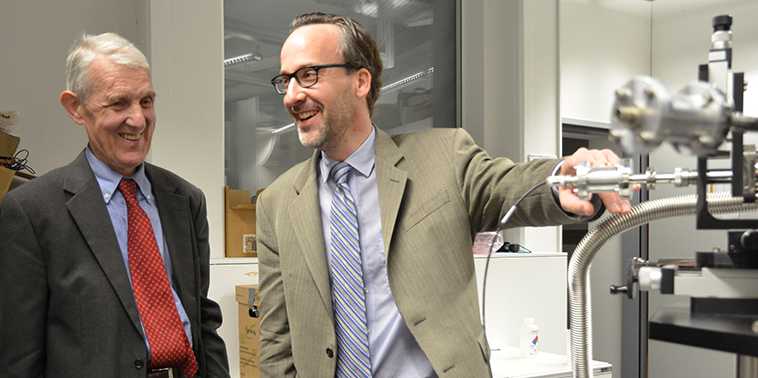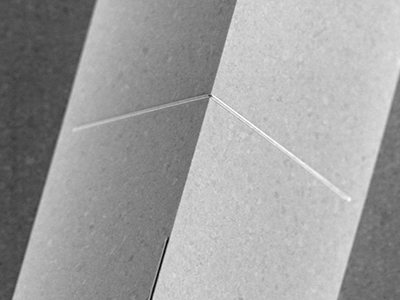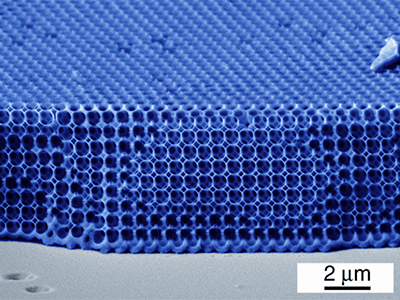From Laser to Spaser
This year’s Rössler Prize has been awarded to David J. Norris. The materials engineering professor in the Department of Mechanical and Process Engineering researches nano-optics at the interface of chemistry, materials and engineering.
At the ETH Zurich Foundation’s “Thanksgiving” event, 47-year-old American, David Norris was presented with the Rössler Prize for his research. The prize includes an award of 200,000 Swiss francs. Since 2009, this prize has been awarded to promising researchers at ETH Zurich who are currently in the expansion phase of their careers. Norris is the first person from the Department of Mechanical and Process Engineering (D-MAVT) to receive this distinguished award.
“This is a great honour for me and a great surprise too…” says Norris, who also heads up the Optical Materials Engineering Laboratory. He continues, “There are some very impressive names on the list of previous winners.”
Norris is an outstanding choice according to Detlef Günther, ETH Zurich Vice President for Research and Corporate Relations, “Not only is he an innovative researcher, he also stands out for his inspirational lectures and commitment to the university.”
“The awardee is a solid researcher with unusual and creative ideas,” adds prize sponsor Max Rössler. “I’m very impressed with his work in nanotechnology to date. His research has great potential for industrial and medical applications. ”
An Interdisciplinary Chemist
David Norris is not your typical mechanical engineer. His research is positioned at the interface between materials science, optics and physical chemistry. He specialises in fabricating and studying synthetic optical materials that do not exist in nature. The goal is to discover structures that interact with light in new and interesting ways.
For instance, he and his colleagues have created a specially structured thin silicon film that extinguishes light of a specific wavelength in its interior. “It was a huge challenge to construct a material that exhibits this special property,” says Norris. It required fabricating the silicon in a way that created nano-sized pores without any irregularities in the pattern. In the end, the solution – “as a chemist, I try to find the simplest approach possible” – was as elegant as it was clever. Norris and his colleagues used minute glass beads that organise themselves spontaneously into grid-like patterns. They then filled the spaces between with silicon and etched away the glass beads. The resulting material was used to study new optical phenomena.
Rainbow Frogs and Spasers
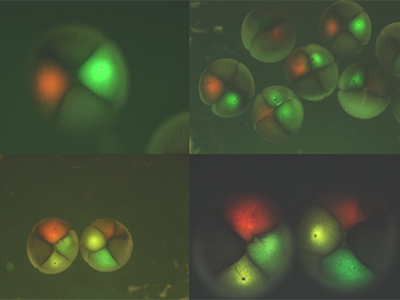
Norris also works with materials known as quantum dots. Thanks to several decades of research, they are now being used in the latest generation of televisions to provide the red and green colours that we see on the screen. The quantum dots Norris works with are particles of cadmium selenide that measure between 2 and 8 nanometres. When these particles are illuminated with blue light, they glow in different colours depending on their size.
Norris has conducted remarkable experiments with quantum dots. For instance, his colleagues injected them as fluorescent dyes into individual cells in an early-stage frog embryo. They then watched as the embryo developed into a tadpole. With each cell division, the injected quantum dots partitioned between the daughter cells. By watching the glow of the quantum dots, they could trace which tissue in the frog came from the initially injected cell. “These ‘rainbow frogs’ were really just a playful way to illustrate the potential and operating principle of quantum dots in biological imaging,” says Norris. However, because the quantum dots contain cadmium, which is toxic, other materials must be used for medical applications.
Another focus of Norris’ research is the use of surface plasmons, a special type of light wave that exists on metal surfaces. By patterning this surface with the appropriate structure (e.g., a sharp tip or ridge), the surface plasmons can be used to concentrate light into a much smaller nanometre-scale volume than would be possible with normal lenses. Applications include solar cells, sensors and imaging techniques.
One particular target for his research in this area is a new device called a “spaser.” Recently, his group has constructed a tiny nanoscale ridge from silver with two integrated mirrors, separated 10 micrometres apart. This is six times smaller than the width of a human hair. Quantum dots were then printed precisely on the ridge in collaboration with the group of Professor Dimos Poulikakos, also in D-MAVT. When the quantum dots are illuminated and glow, they produce surface plasmons that move along the ridge, bouncing back and forth between the mirrors.
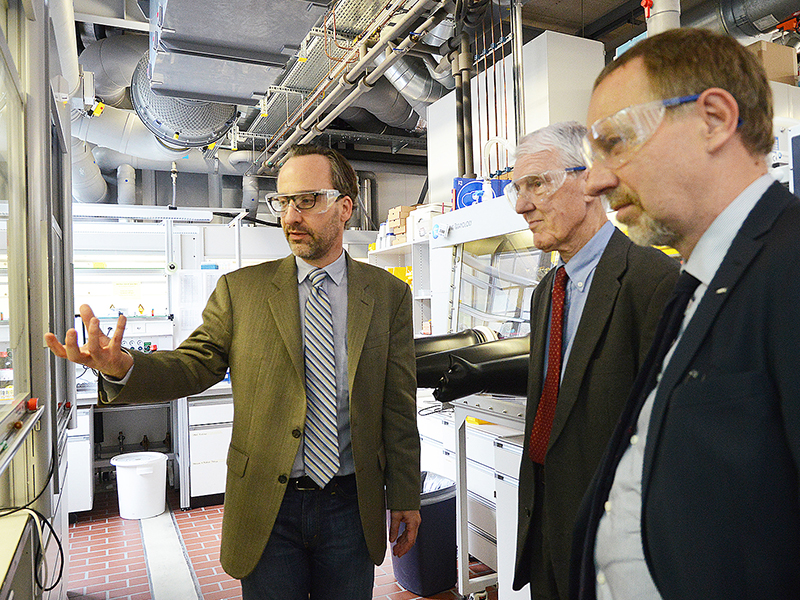
This is the first step toward creating a potential new kind of nano-laser – called a spaser. Norris received an ERC Advanced Grant for this project in 2013. “Although we’re still at the beginning of this research, we are starting to make a 20-year-old dream of mine come true,” says Norris. “We can control so many properties in modern materials. We can now combine them in new ways and it is not always easy to predict what will happen. This is why it’s exciting.”
From Chicago to Zurich
Norris is originally from Chicago. His scientific career began when he completed a bachelor’s degree in chemistry at the University of Chicago. He received his doctorate in physical chemistry from MIT in 1995. After holding research posts at the University of California, San Diego as well as at the NEC Research Institute in Princeton and the University of Minnesota, Norris accepted a position as professor at ETH Zurich in 2010, where he continues to research and teach today.
Max Roessler Prize ceremony
-
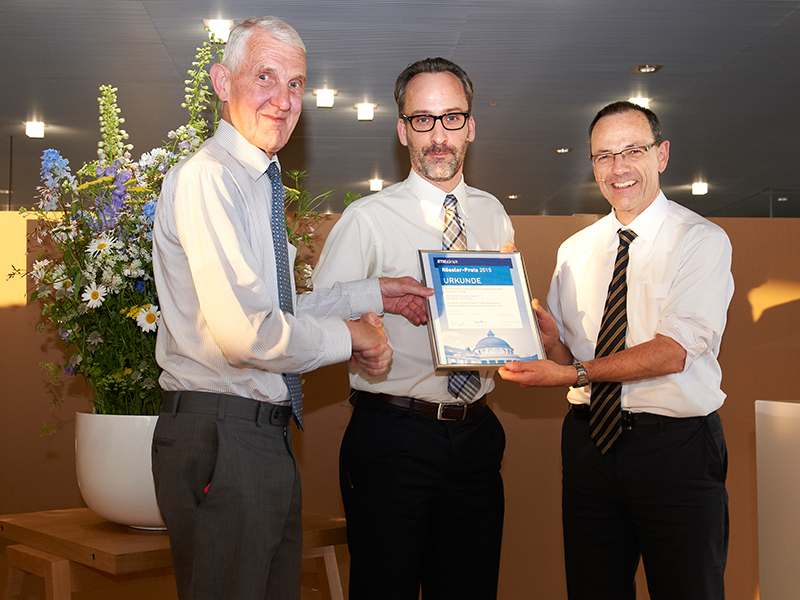
Max Roessler (l.), David Norris and ETH president Lino Guzzella. (all photos: Monika Estermann) -

ETH President Lino Guzzella is acknowledging the laureate. -
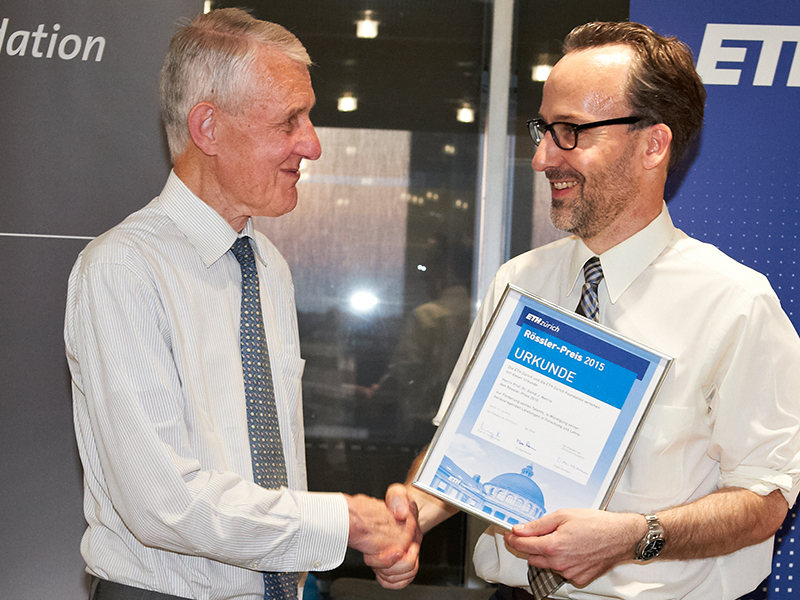
Max Roessler (l.) shaking hands with David Norris, newly selected Roessler Prize winner.
Max Rössler Prize
Max Rössler studied mathematics at ETH Zurich. Afterwards, he worked for a large Swiss bank for more than 20 years before retiring from business life. In 2008, he bequeathed ten million Swiss francs to ETH Zurich Foundation. With the interest, he wanted to finance a yearly sponsorship award for particularly promising ETH professors in the expansion phase of their research careers. The Rössler prize is the most generous award for research at ETH Zurich and is always bestowed at the ETH Zurich Foundation’s "Thanksgiving" event. David Norris is the fifth Rössler award winner. Last year, Christian Wolfrum from the department of Health Sciences and Technology (D-HEST) was honoured with the prize endowed with 200,000 Swiss francs.

